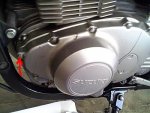Freak
Well-known member
I was at work when i noticed this small pool of oil under the engine.....upon checking it with a friend it wasn't the oil plug, nor the oil filter cap. The only other place where might be coming from is the gasket on the left hand side of the engine. It seemed to be a bit off to the friend who was checking it, also the oil on the fairing was by the front gasket. Now i have never changed a gasket before and i am not even sure if that is the case to begin with. I have ordered one from snow city
http://www.oneidasuzuki.com/store/files/details/d_6699.jpg Number 15
this morning for 9$ which will arrive Thursday. The oil was almost empty....when i got home i saw a small pool of oil where i usually park my bike which made me realized it was leaking before i went to work on it.
Now is there any other place on the left side where it can leak from?? Also can someone help me put it on? My bike is a GS500F 2008. Since i will have to drain all the oil to change the gasket i was thinking of doing the oil change simultaneously which makes more sense.
Suggestion!! Help!!
http://www.oneidasuzuki.com/store/files/details/d_6699.jpg Number 15
this morning for 9$ which will arrive Thursday. The oil was almost empty....when i got home i saw a small pool of oil where i usually park my bike which made me realized it was leaking before i went to work on it.
Now is there any other place on the left side where it can leak from?? Also can someone help me put it on? My bike is a GS500F 2008. Since i will have to drain all the oil to change the gasket i was thinking of doing the oil change simultaneously which makes more sense.
Suggestion!! Help!!

